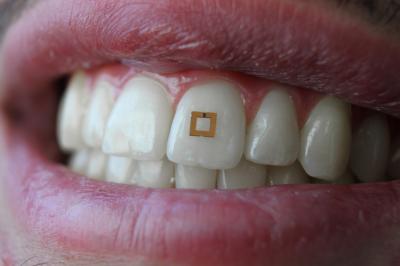
With this latest wearable gadget, you could really sink your teeth into tracking your diet and health.
A tiny tooth-mounted sensor can wirelessly transmit radio frequency data about the foods you’re noshing, reporting on sugar, salt, and alcohol in real time. The creators, led by biomedical engineer Fiorenzo Omenetto of Tufts University, hope that the dental device will someday help consumers and researchers make “conclusive links between dietary intake and health.” They report their prototype in a study that will be published next week in the journal Advanced Materials.
Omenetto’s team has long been working on such radio frequency sensors—ones for the skin, brain, and surgical implants. It made sense to move to the mouth, Omenetto tells Ars. “There are a plethora of markers in the mouth that… are very relevant to our health states,” he said. But it was when the team was in talks with the nutrition researchers at Tufts that they thought “’gee, wouldn’t it be great if you could track your diet.’”The 2mm × 2mm prototypes to do that use their three-layer sensor design. It involves a middle layer of bio-responsive material, sandwiched between two gold, split-ring resonators. The bio-responsive layers in the prototypes were either a silk film or a hydrogel. The silk film can contain things like enzymes or antibodies to detect specific molecules. In doing so, it changes the chemical conditions between the resonators. The hydrogel, on the other hand, sops up the slurries in your pie hole, swelling to different sizes depending on what you’re munching.
The resonators, meanwhile, act like antennas, picking up and transmitting ambient radio frequencies. In early tests, the researchers used a portable radio frequency analyzer attached to a tablet or mobile phone to monitor the frequencies. Those frequencies change depending on what’s going on with the bio-responsive layer of the sensor.
“It’s a passive device,” Omenetto explains. “And you’re pinging it with your phone, essentially.”
In initial tests of the hydrogel-containing prototype, Omenetto and his team had undergraduate researcher Logan Garbarini and other volunteers attach it to their teeth. They then sampled tap water, apple juice, alcohol, mouthwash, and salty soup while donning their grill bling. The tooth-chip transmitted clear frequency shifts with varying sugar, salt, and alcohol intake.
For now, those frequency shifts don’t reveal how much of any of those foods or ingredients you’ve eaten. “There is still a big gap,” Omenetto says. But he says that with more data and testing with common foods, he thinks they’re on the cusp of building in such specificity and sensitivity.
“We’re pretty far away from having the app that tells you, ‘You have consumed 216.3 calories today,’” he said. “But it’s really not implausible to think that you can get there tomorrow.”
When this article is published, it will be available here:
Advanced Materials, 2018. DOI: 10.1002/adma.201703257 (About DOIs).
reader comments
60